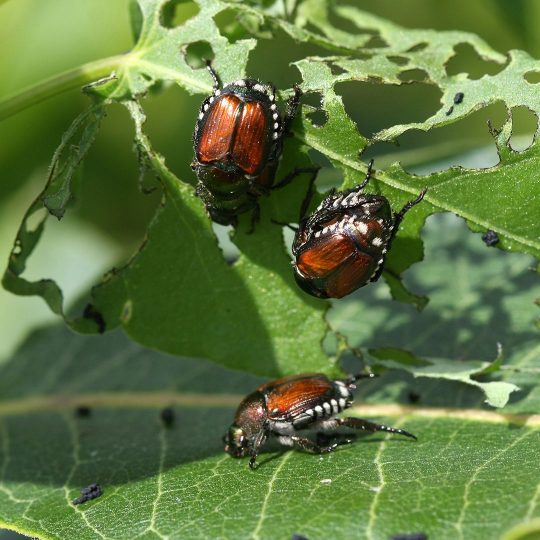Tree Pest Spotlight: Japanese Beetle
How to Spot & Control These Pests
Posted
May 25, 2017

Signs of summer: warm weather, longer days, and the Japanese beetle. You may see the plastic bag traps hanging near your neighbor’s garden, or you’ll see the green garden beetles flying around your yard. Here’s how to spot them and what to do to get rid of them.
What Are Japanese Beetles
Though they may be small, they can do some mighty damage to your garden. These Japanese immigrants eat just about any plant or crop—some of their favorites are roses, beans, and grapes. You may see their damage before you see them. A devoured leaf will only have its veins remaining. The beetles have blue-green heads, copper backs, and tan wings. Where there’s one, there are others since they usually feed in small groups—making even more of a mess.
While they’re flying around in June, they are also laying eggs that can last the winter months in your soil. They may not live very long—only about 40 days—but they can do a lot of damage and cover a lot of ground during this time.
How to Protect Your Plants from the Japanese Beetle
Taking care of your garden—including regular watering and fertilizing—can reduce the damage these beetles cause. Remove dead and diseased plants or fruits which can attract the beetles. To rid your garden of the pests, following these tips:
- When beetles are in the grub stage-late spring and fall–spray the lawn with a soapy solution: two tablespoons of liquid dishwashing soap diluted in one gallon of water per 1,000 square feet. The grubs will surface and the birds will have a smorgasbord. Spray once each week until no more grubs surface.
- Pick them off your plants. Doing this regularly may be time consuming, but it’s the cheapest and most effective way of getting them off. Drop them in a soap and water solution and they will likely drown.
- Cover your plants during the prime six to eight week feeding period. The beetles are most active in the morning, so you can also use a drop cloth to capture them and dump them in soapy water.
- Japanese beetle traps are available at your local lawn and garden store. However, since beetles are attracted to the traps, you may get more than you bargained for visiting your yard. Make sure to place the traps away from your garden so the pests are not tempted to make a pit stop on the way to the trap.
- You can make your own trap with a can of fruit cocktail. Let it sit in the sun to ferment, then place in a light-colored container with water. The beetles will be attracted to the sweet scent but drown in the water.
- Japanese beetles are attracted to geraniums. However, eating the blossoms make them dizzy and fall over, giving you the opportunity to collect and dispose of them.
- Certain plants deter beetles—such as garlic, rue, or tansy. Plant these deterrents near your affected plants.
If none of these suggestion seem to be helping your beetle situation, contact the specialists at Elite Tree Care for more options.